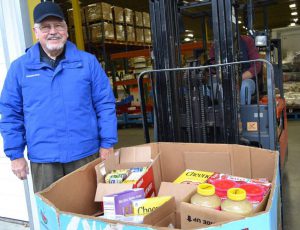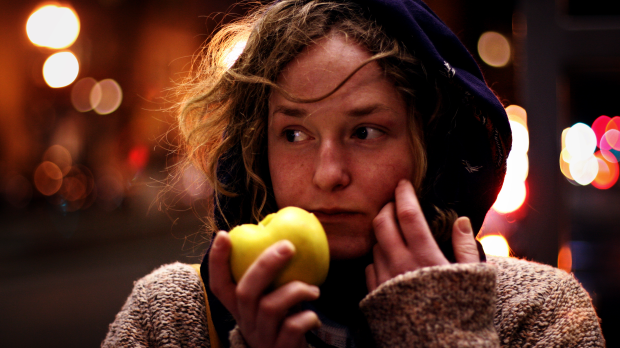You’re in the supermarket buying tomatoes, and one accidentally rolls onto the floor, rendering it soft on one side. Do you put it back on the pile, thinking it’s the store’s problem now, or do you throw it in with your other picks, figuring it will be fine in a soup or a salsa?
Do you pour milk down the drain if it’s a day or two after the marked “sell by” date?
Do you ever wonder if something can be done with the leftover dinner that you don’t have “wrapped” at the restaurant?
Do you cringe when you’re cleaning up after the holiday party, as you dump plates of half-eaten food into the trash?
Most of us see examples of food loss or food waste regularly. Worldwide, the UN Food and Agriculture Organization says up to a third of all food is “spoiled or squandered before it is consumed by people.” In the United States, one organization estimates that about 400 pounds of food per person is wasted annually, yet one in seven Americans goes hungry each day.
More and more, however, individuals and charitable organizations are finding ways to salvage food and get it to those who need it most.
“More than enough food is getting thrown away to feed all these people,” said Rachel Novick, director of the Minor in Sustainability at the University of Notre Dame.
Food insecurity is the obvious reason to try to salvage agricultural products, but there are environmental reasons as well. A Harvard University report says that approximately 21% of the United States’ fresh water supply and 300 million barrels of oil are used to produce food that goes to waste.
Food loss and waste are found everywhere, from farms to homes. Low market prices and high labor costs often make it uneconomical for farmers to harvest all that they produce, says ReFED, a collaboration of over 30 business, nonprofit, foundation, and government leaders committed to reducing food waste in the U.S. “Strict cosmetic standards result in insufficient demand for imperfect-looking produce (i.e. oversized zucchinis or bent carrots),” ReFED says in the report “Rethinking Food Waste through Economics and Data: A Roadmap to Reduce Food Waste. “Despite gleaning and farm-to-food-bank efforts to recover this unharvested food, the vast majority is left in the fields.”
The problem has been on the radar of several charitable organizations for years. The New Hampshire Food Bank, a program of Catholic Charities of New Hampshire, provides more than 12 million pounds of food each year to food pantries, homeless shelters, food banks, soup kitchens and about 400 other registered non profits throughout the state, according to Kathryn Marchocki, spokeswoman for Catholic Charities New Hampshire. The agency sponsors several innovative programs to make sure good food doesn’t go to waste, collaborating with grocery chains and retailers that “have high quality food that is nearing its shelf life, to make sure that it doesn’t get thrown away,” Marchocki said. “They’ll pull this food—mostly meat—freeze it and provide it to us.”

Donated food is also used in a Food Bank program called Recipe for Success, an umbrella program for a variety of outreach efforts including nutrition education, addressing child hunger, and job training. The Culinary Job Training Program teaches people who are unemployed or underemployed or suffering hardships the skills needed to get jobs in the food industry, Marchocki said. “They have a warehouse with a kitchen where they teach these trainees and prepare scores of meals a day,” she explained.
Helen Costello, program manager of the New Hampshire Food Bank, said the program facilitates the distribution of donated produce that may be hard for individuals to process.
“If a farmer donates 1500 pounds of blue Hubbard squash, which has a very hard coating on it, it’s hard to distribute because families might not know what to do with it or even have something to crack it open,” Costello said. “So in our kitchen they’ll be able to prepare that and freeze it, so often it cuts down on my need to purchase frozen vegetables.”
In addition, chefs in the program have gone to farmers markets, gleaned “ugly veggies” and cooked up vegetable dishes on the spot in a mobile kitchen, she said. On-site demos give customers ideas for using more fresh fruits and vegetables in sustainable ways, and discouraging food waste.
Catholic Charities of Central Colorado runs a soup kitchen that serves over 215,000 meals annually. Its food budget is $50,000, but 95% of what they use is donated, according to Catholic Charities spokeswoman Rochelle Blaschke Schlortt.
But whatever is left over still has a life.
“Our community is very aware of food waste,” Schlortt said. “Here at Catholic Charities, we try not to waste anything and have partners who take food product that we cannot use. … Sometimes we’ll get an enormous load of bananas and can’t use them quickly enough. We’ll make a banana pudding, or the zoo will come and pick up the excess, or the pig farmer takes dented cans.” Leftovers from the daily meal are packaged and sent home with clients for dinner.
“We regularly get food from Whole Foods or Starbucks who have food left over at the end of the day that they can’t use the next day,” Schlortt continued. “Our volunteers go around with a truck to pick up from them. The people who run our soup kitchen have experience in the grocery business and hospitality. They understand that if a carton of milk has a sell-by date of Dec. 5, if it’s handled properly in the grocery store they know that that sell-by date means it’s probably still good until Dec. 10.”
Catholic Charities has been running the soup kitchen since 1994 and has been following these practices from the beginning. It serves between 600-800 meals a day, and has never had a case of food poisoning, Schlortt said.
Unfortunately, the concern over liability keeps many entities from donating food in this litigious society. But there are “Good Samaritan” laws on the books that protect from liability, Notre Dame’s Novick said. “The important thing is to educate individuals and organizations about the protections and make sure they understand what kinds of things they can donate.”
A “best by” date on a product is not the same thing as an expiration date, for example.
One thing that has helped push forward efforts to redirect about-to-be-wasted food to the hungry is federal tax exemptions. “That’s helped organizations offset the cost of food and shipping it to where it’s needed,” Novick said, “especially with farms donating imperfect produce.”
Novick said that there are a lot of initiatives on college campuses, such as the Food Recovery Network and the Campus Kitchen Project. At Notre Dame, she said, “We’ve been sending food to some local shelters and rescue missions in South Bend for years. We want to expand beyond dining hall food. There are also little cafes, catering events, campus restaurants.”
The ReFed report says that several social enterprises have emerged recently to sell value-added products from food waste at a profit. These include Barnana (banana snack bites from rejected products), Misfit Juicery (repurposing wasted food into juice), and MM Local Foods (value-added products from seconds from farms).
Technology is also coming to the rescue. A new app that made its debut in San Francisco locates places with unused food so that it can be driven to shelters and churches. Another, in the European Union, alerts consumers to deals on items nearing their expiration dates.
Europe, in fact, seems to be just as concerned about wasted food. A company in Germany picks up “odd-looking” edibles and cooks them for catered events. And many French supermarkets, such as Intermarche, below, offer discounts on “ugly” fruits and vegetables — sometimes as much as 30 percent.
At a time when food insecurity shows little sign of abatement, some people are being just as creative as the best chefs in the industry to keep food out of landfills and fill the stomachs of the hungry.

